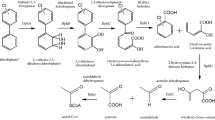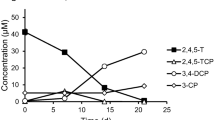Abstract
A series of experiments was conducted to examine the effects of chemical pretreatment on biodegradation of14C-labeled PCB congeners in aqueous systems. Fenton's reagent was used to generate hydroxyl radicals (OH) which were successful in partially oxidizing/transforming otherwise recalcitrant molecules of tetrachlorinated PCB, but had little or no impact on the biodegradation of a monochlorinated congener. Application of Fenton's reagent (1% H2O2, 1 mM FeSO4) followed by inoculation with pure culturesPseudomonas sp, strain LB 400 andAlcaligenes eutrophus, strain H850 resulted in the removal of approximately 38% of 2-chlorobiphenyl and 51% of 2,2′, 4,4′-tetrachlorobiphenyl in the form of14CO2. Comparison of the rate and extent of biodegradation of 2,2′, 4,4′-tetrachlorobiphenyl after the application of Fenton's reagent with the dynamic and final level of radioactivity in the aqueous phase of experimental system suggests two possible means of microbial utilization of tetrachlorinated PCB congener altered by chemical oxidation: (a) consumption of the partially oxidized chemical dissolved in the aqueous phase, and (b) direct microbial attack on the transformed compound, which may still be adhered to the solid surface.
Similar content being viewed by others
References
Abramowicz A. 1990. Aerobic and anaerobic biodegradation of PCBs: a review. Crit Rev Biotechnol 10:241–251.
Adriaens P and DD Focht. 1990. Continuous coculture degradation of selected polychlorinated biphenyl congeners byAcinetobacter spp in the aerobic reactor system. Environ Sci Technol 24:1042–1049.
Alexander M. 1994. Biodegradation and Bioremediation. Academic Press, San Diego, CA.
Anid PJ, L Niles and TM Vogel. 1991. Sequential anaerobic-aerobic biodegradation of PCBs in the river model. In: On-Site Bioreclamation (Hinchee RE and F Olfenbuttel, eds), pp 428–436, Butterworth-Heinemann, Stoneham, MA.
Aronstein BN, YM Calvillo and M Alexander. 1991. Effects of surfactants at low concentrations on the desorption and biodegradation of sorbed aromatic compounds in soil. Environ Sci Technol 25:1728–1731.
Aronstein BN and M Alexander. 1992. Surfactants at low concentrations stimulate biodegradation of sorbed hydrocarbons in samples of aquifer sands and soil slurries. Environ Toxicol Chem 11:1227–1233.
Aronstein BN and M Alexander. 1993. Effect of non-ionic surfactant added to the soil surface on the biodegradation of aromatic hydrocarbons within the soil. Appl Microbiol Biotechnol 39:386–390.
Aronstein BN, RA Lawal and A Maka. 1994. Chemical degradation of cyanides by Fenton's reagent in aqueous and soil-containing systems. Environ Toxicol Chem 13:1719–1726.
Barton MR and RL Crawford. 1988. Novel biotransformations of 4-chlorobiphenyl by aPseudomonas sp. Appl Environ Microbiol 54: 594–595.
Baxter RM and DA Sutherland. 1984. Biochemical and photochemical processes in the degradation of chlorinated biphenyls. Environ Sci Technol 18:608–610.
Bedard DL, R Unterman, LH Bopp, MJ Brennan, ML Haberl and C Johnson. 1984. Rapid assay for screening and characterizing microorganisms for the ability to degrade polychlorinated biphenyls. Appl Environ Microbiol 51:761–768.
Bedard D and ML Haberl. 1990. Influence of chlorine substitution pattern on the degradation of polychlorinated biphenyls by eight bacterial strains. Microb Ecol 20:87–102.
Bergen BJ, WG Nelson and RJ Pruell. 1993. Partitioning of polychlorinated biphenyl congeners in the seawater of New Bedford Harbor, Massachusetts. Environ Sci Technol 27:938–942.
Dilling WL, SJ Gonsior, GU Boggs and CG Mendosa. 1988. Organic photochemistry. 20. A method for estimating gas-phase rate constants for reactions of hydroxyl radicals with organic compounds from their relative rates of reactions with hydrogen peroxide under photolysis in 1,1,2-trichlorotrifluoroethane solution. Environ Sci Technol 22: 1447–1453.
Elsenreich SL, PD Capel, JA Robbins and R Bourbonniere. 1989. Accumulation and diagenesis of chlorinated hydrocarbons in lacustrine sediments. Envrion Sci Technol 6:1116–1126.
Funke B, M Kolb, P Jaser and R Braun. 1994. Treatment of aniline containing waste water by Fenton's reagent. Acta Hydrochim Hydrobiol 22:6–9.
Furukawa K and AM Chakrabarty. 1982. Involvement of plasmids in total degradation of chlorinated biphenyls. Appl Environ Microbiol 44: 619–626.
Gibson DT, DL Cruden, JD Haddock, GJ Zylstra and JM Brand. 1993. Oxidation of polychlorinated biphenyls byPseudomonas sp strain LB400 andPseudomonas pseudoalcaligenes KF707. J Bacteriol 175: 4561–4564.
Goldstein S, D Meyerstein and G Czapski. 1993. The Fenton's reagents. Free Rad Biol Med 15:435–445.
Havel J and W Reineke. 1993. Degradation of Aroclor 1221 in soil by a hybrid pseudomonad. FEMS Microbiol Lett 108:211–218.
Hickey WJ, V Brenner and DD Focht. 1992. Mineralization of 2-chloro-and 2,5-dichlorobiphenyl byPseudomonas sp strain UCR2. FEMS Microbiol Lett 98:175–180.
Hickey WJ, DB Searles and DD Focht. 1993. Enhanced mineralization of polychlorinated biphenyls in soil inoculated with chlorobenzoatedegrading bacteria. Appl Environ Microbiol 59:1194–1200.
Horzempa LM and DM Di Toro. 1983. PCB partitioning in sedimentwater systems: the effect of sediment concentration. J Environ Qual 12:373–380.
Kelley RL, WK Gauger and VJ Srivastava. 1991. Application of Fenton's reagent as a pretreatment step in biological degradation of polyaromatic hydrocarbons. In: Gas, Oil, Coal and Environmental Biotechnology III (Akin C and J Smith, eds), pp 105–120. Institute of Gas Technology, Chicago, IL.
Kong HL and GS Sayler. 1983. Degradation and total mineralization of monohalogenated biphenyls in natural sediment and mixed microbial cultures. Appl Environ Microbiol 46:666–672.
Koppenol WH. 1993. The centennial of the Fenton's reaction. Free Rad Biol Med 15:645–651.
Matsunaga K, M Kondo, S Yamabe and T Mori. 1993. Biomimetic chemical degradation of polychlorobiphenyls below 100°C. Chemosphere 27:2317–2324.
Morita M, M Nakagawa and C Rappe 1978. Polychlorinated dibenzofuran (PCDF) formation from PCB mixture by heat and oxygen. Bull Environ Contam Toxicol 19:665–670.
Pignatello JJ. 1992. Dark and photoassisted Fe3+-catalyzed degradation of chlorophenoxy herbicides by hydrogen peroxide. Environ Sci Technol 26:944–951.
Schwartz RD. 1981. A novel reaction: meta hydroxylation of biphenyl by an actinomycete. Enzyme Microbiol Technol 3:158–159.
Sedlak DL and AW Andren. 1991. Oxidation of chlorobenzene with Fenton's reagent. Environ Sci Technol 25:777–782.
Sedlak DL and AW Andren. 1991. Aqueous-phase oxidation of polychlorinated biphenyls by hydroxyl radicals. Environ Sci Technol 25:1419–1427.
Sehested K and EJ Hart. 1975. Formation and decay of the biphenyl radical in aqueous acidic solution. Phys Chem 79:1039–1042.
Sondossi M, M Sylvestre, D Ahmad and R Masse. 1991. Metabolism of hydroxybiphenyl and chloro-hydroxybiphenyl/chlorobiphenyl degradingPseudomonas testosteroni, strain B-356. J Ind Microbiol 7: 77–88.
Spadaro JT, L Isabelle and V Renganathan. 1994. Hydroxyl radical mediated degradation of azo dyes: evidence for benzene generation. Environ Sci Technol 28:1389–1393.
Sun Y and JJ Pignatello. 1992. Chemical treatment of pesticide wastes. Evaluation of Fe (III) chelates for catalytic hydrogen peroxide oxidation of 2,4-D at circumneutral pH. J Agric Chem 40:322–327.
Thomas DR, KS Carswell and G Georgiou. 1992. Mineralization of biphenyl and PCBs by the white rot fungusPhanerochaete chrysosporium. Biotech Bioeng 40:1395–1402.
Voice TC, CP Rice and WJ Weber, Jr. 1983. Effect of solids concentration on the sorptive partitioning of hydrophobic pollutants in aquatic systems. Environ Sci Technol 17:513–518.
Zepp RG, BC Faust and J Holgne. 1992. Hydroxyl radical formation in aqueous reactions (pH 3–8) or iron (ii) with hydrogen peroxide: the photo-Fenton reaction. Environ Sci Technol 26:313–319.
Zhang P-C, RJ Scrudato, JJ Pagano and RN Roberts. 1993. Photodecomposition of PCBs in aqueous systems using TiO2 as catalyst. Chemosphere 26:1213–1223.
Author information
Authors and Affiliations
Rights and permissions
About this article
Cite this article
Aronstein, B.N., Paterek, J.R., Kelley, R.L. et al. The effect of chemical pretreatment on the aerobic microbial degradation of PCB congeners in aqueous systems. Journal of Industrial Microbiology 15, 55–59 (1995). https://doi.org/10.1007/BF01570014
Received:
Accepted:
Issue Date:
DOI: https://doi.org/10.1007/BF01570014




